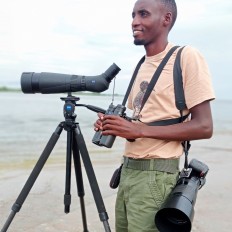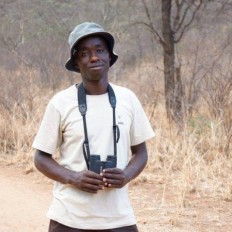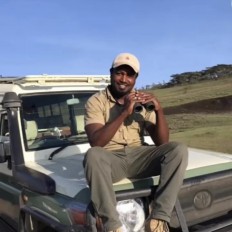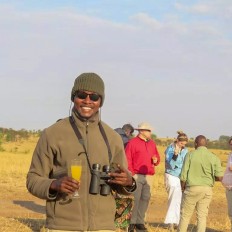Top species
- Blue-spotted Wood-Dove (Turtur afer)
- Green Malkoha (Ceuthmochares australis)
- African Harrier-Hawk (Polyboroides typus)
- Crowned Eagle (Stephanoaetus coronatus)
- Pel's Fishing-Owl (Scotopelia peli)
- Southern Ground-Hornbill (Bucorvus leadbeateri)
- Crowned Hornbill (Lophoceros alboterminatus)
- Trumpeter Hornbill (Bycanistes bucinator)
- Böhm's Bee-eater (Merops boehmi)
- Brown-necked Parrot (Poicephalus fuscicollis)
- Dark Batis (Batis crypta)
- African Crested Flycatcher (Trochocercus cyanomelas)
- White-tailed Crested Flycatcher (Elminia albonotata)
- Kretschmer's Longbill (Macrosphenus kretschmeri)
- White-winged Apalis (Apalis chariessa)
- Chapin's Apalis (Apalis chapini)
- Shelley's Greenbul (Arizelocichla masukuensis)
- Stripe-cheeked Greenbul (Arizelocichla milanjensis)
- Little Greenbul (Eurillas virens)
- Terrestrial Brownbul (Phyllastrephus terrestris)
- Fischer's Greenbul (Phyllastrephus fischeri)
- Olive-flanked Robin-Chat (Cossypha anomala)
- Spot-throat (Modulatrix stictigula)
- Olive Sunbird (Cyanomitra olivacea)
- Moreau's Sunbird (Cinnyris moreaui)
- Magpie Mannikin (Spermestes fringilloides)
- Lesser Seedcracker (Pyrenestes minor)
List up to ca. 25 species that:
• have a limited distribution range and/or are rare on a global level
• are most sought-after by birdwatchers at this site
• and are relatively easy to see at this site (year-round or seasonally)
| Blue-spotted Wood-Dove (Turtur afer) | |
| Green Malkoha (Ceuthmochares australis) | |
| African Harrier-Hawk (Polyboroides typus) | |
| Crowned Eagle (Stephanoaetus coronatus) | |
| Pel's Fishing-Owl (Scotopelia peli) | |
| Southern Ground-Hornbill (Bucorvus leadbeateri) | |
| Crowned Hornbill (Lophoceros alboterminatus) | |
| Trumpeter Hornbill (Bycanistes bucinator) | |
| Böhm's Bee-eater (Merops boehmi) | |
| Brown-necked Parrot (Poicephalus fuscicollis) | |
| Dark Batis (Batis crypta) | |
| African Crested Flycatcher (Trochocercus cyanomelas) | |
| White-tailed Crested Flycatcher (Elminia albonotata) | |
| Kretschmer's Longbill (Macrosphenus kretschmeri) | |
| White-winged Apalis (Apalis chariessa) | |
| Chapin's Apalis (Apalis chapini) | |
| Shelley's Greenbul (Arizelocichla masukuensis) | |
| Stripe-cheeked Greenbul (Arizelocichla milanjensis) | |
| Little Greenbul (Eurillas virens) | |
| Terrestrial Brownbul (Phyllastrephus terrestris) | |
| Fischer's Greenbul (Phyllastrephus fischeri) | |
| Olive-flanked Robin-Chat (Cossypha anomala) | |
| Spot-throat (Modulatrix stictigula) | |
| Olive Sunbird (Cyanomitra olivacea) | |
| Moreau's Sunbird (Cinnyris moreaui) | |
| Magpie Mannikin (Spermestes fringilloides) | |
| Lesser Seedcracker (Pyrenestes minor) |
Olive-flanked Robin-Chat (Cossypha anomala) was added by Isaac Kilusu (2021-07-20 08:16:39)
Little Greenbul (Eurillas virens) was added by Isaac Kilusu (2021-07-20 08:16:15)
Spot-throat (Modulatrix stictigula) was added by Isaac Kilusu (2021-07-20 08:15:48)
Dark Batis (Batis crypta) was added by Isaac Kilusu (2021-07-20 08:15:14)
Olive Sunbird (Cyanomitra olivacea) was added by Isaac Kilusu (2021-07-20 08:14:39)
Green Malkoha (Ceuthmochares australis) was added by Isaac Kilusu (2021-07-20 08:14:22)
Kretschmer's Longbill (Macrosphenus kretschmeri) was added by Isaac Kilusu (2021-07-20 08:13:34)
White-winged Apalis (Apalis chariessa) was added by Isaac Kilusu (2021-07-20 08:12:07)
Brown-necked Parrot (Poicephalus fuscicollis) was added by Isaac Kilusu (2021-07-20 08:11:43)
Southern Ground-Hornbill (Bucorvus leadbeateri) was added by Isaac Kilusu (2021-07-20 08:11:04)
Moreau's Sunbird (Cinnyris moreaui) was added by Isaac Kilusu (2021-07-20 08:10:37)
African Harrier-Hawk (Polyboroides typus) was added by Isaac Kilusu (2021-07-20 08:10:15)
Chapin's Apalis (Apalis chapini) was added by Isaac Kilusu (2021-07-20 08:08:18)
Magpie Mannikin (Spermestes fringilloides) was added by Isaac Kilusu (2021-07-20 08:03:46)
Trumpeter Hornbill (Bycanistes bucinator) was added by Isaac Kilusu (2021-07-20 08:02:37)
Crowned Hornbill (Lophoceros alboterminatus) was added by Isaac Kilusu (2021-07-20 08:02:00)
Blue-spotted Wood-Dove (Turtur afer) was added by Isaac Kilusu (2021-07-20 08:01:12)
African Crested Flycatcher (Trochocercus cyanomelas) was added by Isaac Kilusu (2021-07-20 08:00:07)
White-tailed Crested Flycatcher (Elminia albonotata) was added by Isaac Kilusu (2021-07-20 07:57:29)
Böhm's Bee-eater (Merops boehmi) was added by Isaac Kilusu (2021-07-20 07:55:38)
Terrestrial Brownbul (Phyllastrephus terrestris) was added by Isaac Kilusu (2021-07-20 07:55:08)
Stripe-cheeked Greenbul (Arizelocichla milanjensis) was added by Isaac Kilusu (2021-07-20 07:54:34)
Shelley's Greenbul (Arizelocichla masukuensis) was added by Isaac Kilusu (2021-07-20 07:53:21)
Fischer's Greenbul (Phyllastrephus fischeri) was added by Isaac Kilusu (2021-07-20 07:52:53)
Crowned Eagle (Stephanoaetus coronatus) was added by Isaac Kilusu (2021-07-20 07:50:47)
Lesser Seedcracker (Pyrenestes minor) was added by Isaac Kilusu (2021-05-17 14:56:13)
Pel's Fishing-Owl (Scotopelia peli) was added by Isaac Kilusu (2021-05-17 14:55:41)




